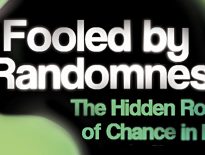Fooled By Randomness 2 – Monte Carlo

Today’s post is our second visit to Nassim Nicolas Taleb’s modern classic Fooled By Randomness.
Contents
Monte Carlo
Many people will be familiar with Monte Carlo analysis, of which Taleb is a big fan.
- It’s a method for (amongst other things) generating large numbers of alternative histories via random selection from a limited dataset.
- It’s named for the idea that the roulette wheel in the casino at Monte Carlo is a random number generator (in practice, all wheels will have some form of bias.
Monte Carlo is a useful tool, but it has one limitation (in my opinion).
- Equity markets show sequencing effects – sharp crashes are usually followed by sharp recoveries.
- There’s also a tendency for crashes to occur when starting valuations are high.
Random sampling ignores these features.
- In some situations, this won’t matter too much.
- But when for example we are calculating maximum withdrawal rates from retirement pots, it’s better to use cohort analysis with historical monthly returns.
Alternative histories are also known as sample paths, a term from the mathematics of stochastic processes.
- Stochastic just means random.
Taleb notes that random does not mean equiprobable.
- In most situations, some steps will be more likely than others.
Market simulations
In the 1990s, when cheap computers started to become available, Taleb ran market simulations using populations made up of:
- idiotic bulls
- impetuous bears
- cautious traders
Almost nobody really survived; bears dropped out like flies in the rally and bulls ended up being slaughtered, as paper profits vanished when the music stopped.
But there was one exception; some of those who traded options (I called them option buyers) had remarkable staying power and I wanted to be one of those.
Blow-ups
Thus began Taleb’s obsession with being insured against blow-ups.
The blowup is different from merely incurring a monetary loss; it is losing money when one does not believe that such a fact is possible at all. Blown-up traders think that they knew enough about the world to reject the possibility of the adverse event taking place: there was no courage in their taking such risks, just ignorance.
“All of my colleagues who I have known to denigrate history blew up spectacularly. They all made claims to the effect that “these times are different” or that “their market was different”. They were unable to accept that the experience of others was out there, in the open, freely available to all.
Hindsight
Things are always obvious after the fact. When you look at the past, the past will always be deterministic, since only one single observation took place.
The over-estimation of what one knew at the time is called hindsight bias.
A mistake is not something to be determined after the fact, but in the light of the information until that point.
Our minds are designed to understand how the world works, but, rather, to get [us] out of trouble rapidly and have progeny. If they were made for us to understand things, it would slow us down so much that we would have trouble operating.
Why is why we need short cuts – the System 1 heuristics that underpin our behavioural biases.
Ergodicity
History is potent enough to deliver, in the medium to long run, most of the possible scenarios, and to eventually bury the bad guy. Bad trades catch up with you.
This is ergodicity.
Very long sample paths end up resembling each other. The properties of a very, very long sample path would be similar to the properties of an average of shorter ones.
Newness
Progress means [only] that some new information is better than past information, not that the average of new information will supplant past information, which means that it is optimal to systematically reject the new idea, information, or method.
The argument in favor of “new things” goes as follows: Look at the dramatic changes that have been brought about by the arrival of new technologies, such as the automobile, the airplane, the telephone, and the personal computer.
Middlebrow inference would lead one to believe that all new technologies and inventions would likewise revolutionize our lives.
But of course, once again we are only looking at the winners.
- Taleb’s advice is to Cut Out The Noise and ignore the news.
If there is anything better than noise in the mass of “urgent” news pounding us, it would be like a needle in a haystack.
Shiller
Taleb is a fan of Robert Shiller, and quotes his 1981 paper on the volatility of markets.
- This says that prices are too volatile to reflect discounted cash flows or dividends.
- Rational expectations (eg. from newsflow) were not being followed.
In other words, markets are not efficient in the EMH sense.
Gerontocracy
Taleb prefers old and experienced investors and traders, rather than the youngest/most profitable in recent times.
- His Monte Carlo simulations showed a significant advantage in selecting “aged” traders, defined as years of experience without blowing up (rather than monetary success).
When regime-switching (discussed in a later chapter) occurs, the older traders appear to be more resistant.
Taleb quotes a study which shows that women prefer to mate with healthy older men rather than healthy younger ones, as they are more resistant to life.
- Similarly, insurers in renaissance Italy charged the same for a man in his twenties as they did for a man in his fifties:
A sign that they had the same life expectancy; once a man crossed the forty-year mark, he had shown that very few ailments could harm him.
Timescales
Taleb imagines a strategy with a 15% pa return, and a 10% volatility.
- Over 1 day, this has a 54% chance of a positive return.
- Over 1 year, the odd rise to 93%.
The short-term is dominated by noise (the volatility), the long-term by the signal (the return).
This is a good reason not to check prices too often, as you are more likely to receive bad news.
- A piece of bad news hurts more than good news cheers (( More than twice as much, the studies show )) – it pushes you towards burn-out (the slow-motion version of blow-up).
This is another spin on Cut Out The Noise.
Conclusions
That’s it for today.
- We’ve covered another two chapters, and they went pretty easily – certainly more easily than I remembered from when I last read the book.
Next up are evolution and skewness.
- Until next time.















Your words on Monte Carlo reminded me of this paper from 2015:
https://papers.ssrn.com/sol3/papers.cfm?abstract_id=2548651
Thanks for the link, it looks like an interesting paper. I must write specifically about Monte Carlo sometime.